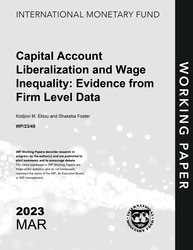
Capital Account Liberalization and Wage Inequality: Evidence from Firm Level Data
Capital Account Liberalization and Wage Inequality: Evidence from Firm Level Data
READ MORE...
Volume/Issue:
Volume 2023
Issue 048
Publication date: March 2023
ISBN: 9798400235139
$20.00
Add to Cart by clicking price of the language and format you'd like to purchase
Available Languages and Formats
| English |
Prices in red indicate formats that are not yet available but are forthcoming.
Topics covered in this book
This title contains information about the following subjects.
Click on a subject if you would like to see other titles with the same subjects.
Exports and Imports , Labor , Economics- Macroeconomics , Economics / General , Wage Inequality , Firm heterogeneity , Capital Account Liberalization , wage dispersion , inflow liberalization , Shakeba foster , baseline result , Income inequality , Wages , Total factor productivity , Wage adjustments
Summary
Firms play an important role in shaping income inequality at the aggregated country level, given that wages represent a significant proportion of household income. We investigate the distributional consequences of capital account liberalization, relying on firm level data to explore the implications for betweenfirms earning inequality in ASEAN5 countries over the period 1995-2019. We find that between-firms wage dispersion alone, accounts for a nontrivial proportion of the variation in the market Gini. Our empirical findings show that capital account liberalization increases between-firms wage inequality, as wages grow faster at initially high-paying firms and slow-down at firms at the lower portion of the wage distribution. These results are robust to a battery of robustness checks. Further, the directions and categories of capital account liberalization matter as results are pronounced for inflow liberalization and equity capital flows. We also show that capital account liberalization induces an increase in Profit-to-Wage ratios. Furthermore, the impact depends on country characteristics (wage setting institutions, the level of financial development and the size of the informal sector) as well as industry characteristics (export orientation and external finance dependence).
Copyright © 2010 - 2026
Powered by:
AIDC



